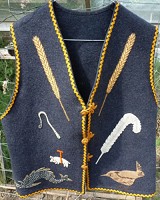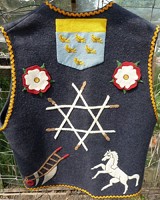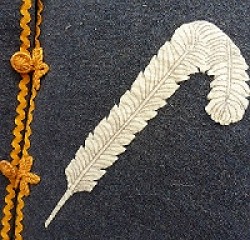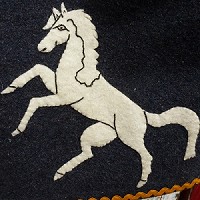Coronation Waistcoats 1953
Whilst celebrating the Queen's Diamond Jubilee, a waistcoat, photos and notes from the Queen's Coronation came to light. Ted Pratt wrote the following text in 1989 about the symbols on his waistcoat.(see pictures from our Coronation Celebrations here).
The occasion was the Coronation 1953. In common with many other organisations in many towns and villages, ways and means of
marking the occasion was discussed and the Club joined in the celebration with Felpham village. In addition to all of this,
our members decided that it would be in keeping with the history of the club that we mark the occasion in a more personal
manner. After some series of weekly talks, it was agreed that we mark the event with the design of 'Men's Waistcoats'.
Folklore was to be the theme and there was a need that each design be authentic in detail.


Ted's Waistcoat
It happened at that time I was a member of the Folklore Society and the Heraldry Society. The combination of the two
organisations gave access to a lot of material. It was important that the symbols used should not be a meaningless
arrangement of figures, but be displayed in a manner that would characterize an identity of purpose and distinction.
Country dancing was also a brief preface on the background of Folklore, its mythology, Dance and Song and Folk ritual with a
little dash of Heraldry will gather the several subjects into a single perspective.
The study of Myth reveals it to
be a cloak or a transparency of folk memory overlaying the bare bones of history. Its study is a very slow process. Its
dating is very difficult. It follows a pattern of sequence and its tales are re-cycled as each generation takes it on.
In attempting to understand it, consideration should be given to the possibility that primitive man in telling these
stories was guilty of deliberate misrepresentation. That is rather unkind, at that point in time primitive Man was
at a disadvantage, that owing to his inability to distinguish the relationship between cause and effect, he was unable
to distinguish between fact and prejudice. So we glimpse Man seeing through the eyes of a child.
So we need to see myth as being symbolical in which case, the identification of the symbols will vary from the good and the
evil according to the whim of that period in time. Remembering of course that these shadowy beginnings
were the making of history. So it is something of a jig-saw puzzle to get it all into a dimension of culture, history and
a religious background.
So folklore is a serious study and by no means a museum of dead things. It is very much alive today in custom and social
relationship among nations. But there is always the nagging thought of why and how.
It was Man's constant
relationship with the forces of nature that gave him his philosophy of life. Man was surrounded by many unknown forces,
but his limited knowledge gave him a simplicity of understanding of things alive and dead. In his simple mind, things
were not dead in the modern sense. To him, the Axe or the Plough, or any such implement, had a consciousness just as a
human being. So he believed that things acted for themselves as an instrument of purpose. Each had the same action of
rage and also kindliness. The raging of the sea, storm and tempest harboured evil spirits. But in kindly mood gave him
sustenance. So cause and effect in the forces of nature harboured a fear and a reverence. But it also raised in his mind
a fear and premonition. So myth and legend and all its customs proliferated in all levels of society in that point in time.
Visual emblems were evidence of the beliefs based on primitive legends. The subject is a vast one, each nation is steeped
in its folk history and equally proud of its heritage.
And so it came about that the 'Men's Waistcoats' were designed
against the background of a rich store of Folklore.
The style of the waistcoats are of interest in an historic sense. The design is based on the Jupon which dates about 1360.
Being sleeveless it was easy to slip on over other clothing. Its significance in the historic scene was its use in the
display of Armoural bearings in battle or jousting, thus giving identification in battle. Such indentification is still
in use in the army today. The Jupon was replaced by the Tabard which gave a change of style. It had sleeves to the elbow
open at the sides and the length of the body extended to mid thigh. The Tabard is still in use by the officers of The Royal
College of Arms and can be seen on occasions of state with its rich decoration of heraldic figures. Another development
in style and design was devised in the form of a mantling or lamborine as it is sometimes called. It is a long cloak
falling from the shoulder to foot worn on ceremonial occasions over the outer clothing. It displays all the richness of
devices and honours bestowed on its wearer. It is worn by man and women alike and forms a part of Orders of Chivalry.
Civic robes of office still preserve the custom. Academics also use the gown in the display of its custom.
The detailing of our waistcoats was very much the choice of its owner according to taste. For my own, it will be of interest
to describe some of the detail. The body of the waistcoat was made out of an old army blanket which I had with me throughout
the war period.
The orange facings are symbolical of the old Sussex regiment colours. The history of the Sussex Regiment
is quite a long one and is worthy of some research available at Chichester Museum. There is a family connection with the
regiment of course, my father served in the regiment in the Boar War and the 1914-18 War and two of my brothers. One who
was killed and is mentioned in the Roll of Honour in the Regimental Chapel in Chichester Cathedral. The regiment was raised
in 1701 by Arthur Chichester the 3rd Earl of Donegal at his own expense and in return for which King William III
gave permission for the regiment to wear orange facings on their uniforms. At that time the regiment was known as the
Belfast Regiment.

In 1831 King William IV gave the regiment the title 'Royal Sussex Regiment' and the uniform gave way to
the blue facings of the 'Royal' personage. The white plumes depicted on the waistcoat represent a part of the regimental
cap badge. It is a battle honour won at a battle in Quebec when the regiment overwhelmed the enemy, they picked up the
white plumes from the battlefield and stuck them in their hats and so history was made.
The other item of interest on the waistcoat is the little pig. It is known as The Tantony Pig. Its connection dates
way back into the 4th century as the sign of St. Anthony the patron saint of the Swineherd.
The little pig represents the smallest of the litter and according to the proverb will follow
its owner about anywhere. It extends way back into prehistory and its image is attached to the Tau Cross signifying
immortality in preserving wisdom. Its reference is used also as being the small bell in the belfrey.

The little Wren is another figure of much interest and a lot of mention in
Folklore of Europe in general terms. In England it is supposed that anyone who kills a Wren, or harries the nest will
suffer some injury or misfortune within the year. In fact it is within my memory that it is always bad luck to touch the
nest of the Wren. In the farming population it was said that if any of the workers touched the nest of the wren the 'cows
will give Blood milk'.

In France it is thought that if anyone kills a Wren or harries its nest, his house will be struck by
lightning or his cattle will be maimed. There are many verses on the power of the Wren. In spite of all of this, the Wren
was hunted in Ireland on Christmas day with great ceremony and his body paraded in great pomp on the end of a pole.
There is a great deal of writing about the Wren from all parts of Europe.
The representation of the Plough of course
typified the growth of crops and the ceremonial rites of seasons. Plough Monday was celebrated on the first Monday after
Twelfth Night. On that day the custom was to drag the plough from house to house and village to village, collecting money
to be spent on rustic revelry in the local tavern. The men who drew the plough were known as Plough Bullolks.
They wore their shirts over their coats and decorated their hat with ribbons and bunches of
wheat. Among them was a man dressed as an old woman called a 'Bessy', under his gown he wore a cows tail. He skipped
and capered around and carried the money box. The performance is similar to the Morris Men who still practice the rites
of the seasons with a greater precision.

These rites are practised throughout Europe in various forms. The object being to promote the fertility of the land. It all has
its roots in mythology and each country has its own version of ritual in verse. Basic to all of these ceremonials is the
calling on the Gods to promote the growth of the crops. If with dancing and performing a ritual movement, they impart their
strength and magic to the Gods. It reflects the magic of creation.

The ears of wheat represent the fertility rites
which are common in folklore.
But in particular this instance is known as 'Garnet's Straw', which dates back to the Gunpowder
Plot 1605. Garnet was in sympathy with many involved in the plot and attended the execution of the conspirators. He
preserved some straw picked up in the area of the trial and preserved the straws in a bottle, when looking at them he
declared that he saw the face of Guy Fawkes! It is fair to say it was his own reflection of course. But that is the folk
tale. You will see a little face in one of the ears of wheat.
The shepherding of sheep in Sussex is not as widespread as the old days, but the symbol of shepherds crook is a reminder
of our attachment to the countryside. Also, it represents the pastoral staff of a Bishop or Abbot. Sussex folklore is rich
in sheep rearing tales and making hurdles for sheep pens was a thriving industry. The jargon used in folk dancing stems from
the weaving pattern of hurdle making in the expression of 'sheep's hey', all of which makes for the many folk legends of
Sussex.


The Lancastrian Rose on the waistcoat in red and the York white are united in the Tudor Rose as a Royal Badge of England.
Its national significance is so displayed as a mark of the Coronation of 1953. Princess Margaret being the President of
The English Folk Dance and Song Society.
The White Horse of the House of Hanover is of course of significance in its
presentation in the Royal Arms. It has local interest in its title of many pubs in and around Sussex. The White Horse was
assigned to the royal shield of the House of Hanover. But not now used by the House of Windsor.
Finally, the Civic Arms of West Sussex are displayed by permission of West Sussex County Council on the occasion of the
Coronation.


The device displayed on its shield of civic arms is the well known Six Sussex Martlets.
Representing the Rapes of the county, (divisions of land dating back to the Norman conquest). Each rape
contained a river as the outlet to the sea and each at that time contained a Castle, and was a self contained
defensive unit and was divided into its 'hundreds'. At that point in time the Church was a very powerful seat of power and
influence.
The history of every county is very rich in its history and its folklore and Sussex is no exception.
So the pattern of the past finds its expression in the spirit of inquiry in its myth and ritual. So many things of the past are still within reach and of course new facts of interest are constantly emerging from patient research into our past history. The piecing together of scraps of information increases the richness of folk customs which reveals the life style of our ancestors. We cannot divorce myth from custom, it makes up our history and I hope this little offering will rouse interest in that direction.
Ted Pratt 18.9.1989

(Cat)Fish
Top of Page
[P.S. There is no reference to the Fish in the notes - perhaps it signifies the local fishing history. The other symbol
not mentioned is the six pointed star made of interlocking swords - this is the motif of the English Dance and Song Society.
Janet Douglas 2012]
